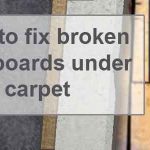As energy prices rise and the cost of heating our homes increases, it is understandable that people want to improve the energy efficiency in their homes.
One of the best ways to do this, is to ensure that your home is well insulated. The main areas to insulate are the external walls of your property and the roof.
According to energy advice portal TheGreenAge, 35%+ of heat is lost through a property’s walls. The roof accounts for a further 25%, and up to 10% is lost through the ground floor. The rest is lost through gaps around windows and doors. As well as the heat lost when people actually open these doors and windows.

Due to this, it makes a lot of sense to ensure the outer envelope of the property is well insulated. Obviously, the main areas people focus on, are the outer walls, and the roof. These two will have the biggest impact on maintaining the overall temperature in a property.
Another area people may add insulation is under floorboards. To do this, you can use loft insulation such as mineral wool, or PIR insulation sheets such as Celotex, in order to achieve an extra layer of insulation.
The main benefit of adding insulation below floorboards, is it will reduce heat loss from individual rooms and between floors. If this is combined with insulation in external walls, and stud walls, it can create an internal envelope, enabling you to keep individual rooms warm.
This can be particularly useful if you only want to heat certain areas of your home.
Also, as we already mentioned previously, up to 10% of heat can be lost through the ground floor. Therefore, it can be quite beneficial to insulate this area where possible.
Insulating the ground floor
In order to reduce the 10% of heat loss that can leave through the ground floor of your property. Adding insulation can be a good solution.
However, the way you do this, will depend on the type of floor you are trying to insulate. The main scenarios include:
Solid concrete floors
There are only two ways to do this. Firstly you can dig out the floor. This will be a huge amount of work and you will need to add a new DPM, rigid insulation, and then pour more concrete.
The second option is to lay insulation above the existing floor. Obviously, this comes with another set of problems, as it will raise the floor level. This will require a lot of adjustments, to things like sockets, skirting boards, radiators, etc.
Both of these scenarios are extremely disruptive. Which means it is usually not worth it for the benefit you would achieve.
Suspended timber floor with a crawl space
In this scenario, the void below the suspended floor can result in considerable heat loss. As a result, insulating can be a very good solution.
The least disruptive way to insulate the floor, would be via the crawl space. This is not the easiest of jobs, but if you can access the void below the floor, you can install insulation from underneath.
You may choose to add some netting below to avoid the insulation falling out.
If you can’t access the crawl space, the only way to insulate this area would be to remove floorboards. Again, this is quite disruptive, as you will need to remove flooring and any furniture above the floor.
Timber floor with a cellar or basement below
If you have a cellar or a basement, this is often the easiest way to insulate under the floorboards of your ground floor.
Access is much easier than a crawl space, and the joists are often exposed from below. If this is the case, you can easily add insulation from the basement.
If you have a ceiling in the basement, you may need to remove it, add insulation, and re-install the ceiling.
Adding loft insulation under floorboards in other areas
You can also add loft insulation under floorboards in the other areas of your house. As we mentioned previously, it will provide extra insulation between floors. However, it can be quite disruptive.
To add insulation under floorboards, you will need to access the area. This will mean removing furniture and flooring, in order to lift the floor boards. Obviously, this is not a small job. With that said, you only need to do it once and the benefit will last for years.
There are definitely more important areas that need insulation. Therefore, if you don’t have sufficient insulation in your external walls or roof, these could be a better area to focus on.
With that said, if you are simply trying to add another layer of insulation, it is completely acceptable to add loft insulation under floorboards in any area of your home.
Conclusion
You can definitely use loft insulation under floorboards. It will provide another layer of insulation between rooms in your property. It can be very effective, especially combined with insulated stud walls and external walls.
The main issue with adding insulation below floorboards is the disruption caused installing it.
In order to access the area, you will often need to move furniture and flooring above. Following this you will need to physically remove floorboards. If this is something you are comfortable with, them by all means do it.




